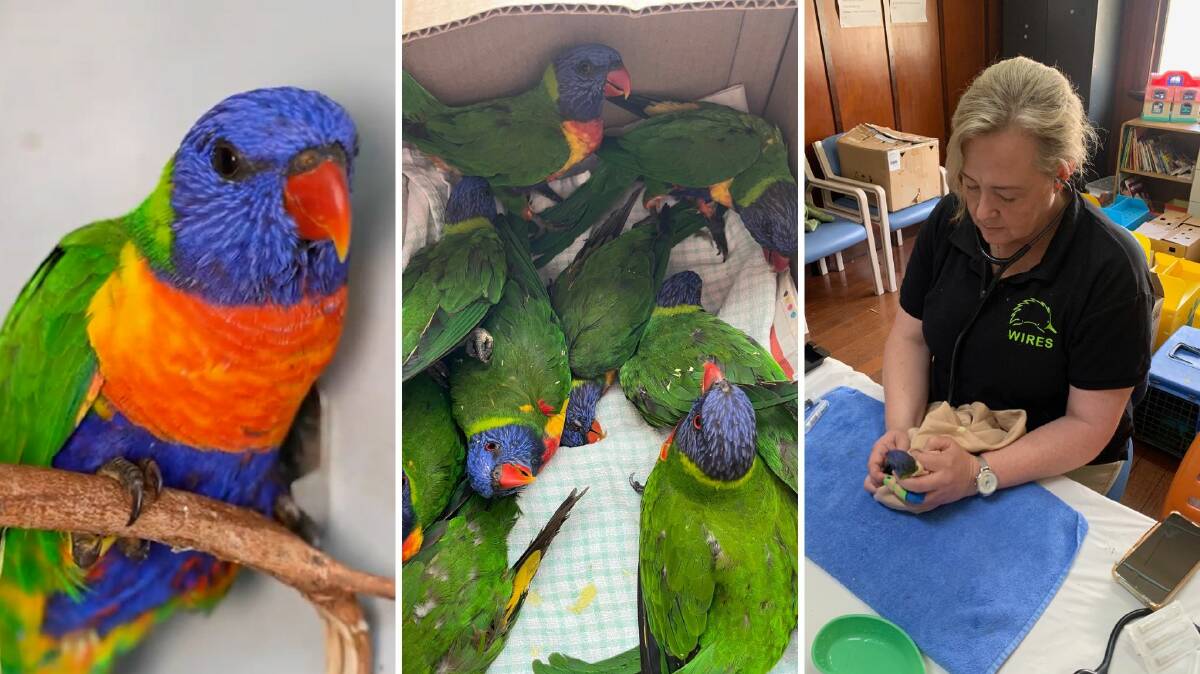Vets and animal rescuers have been inundated with sick, paralysed rainbow lorikeets in parts of northern NSW and Queensland.
The disease causes paralytic responses with birds unable to fly, losing balance and in the most severe cases, unable to blink, drink, or breathe properly.
But the cause of the illness is still unknown, leaving wildlife experts scrambling to find the source of infection before the fatal disease moves further south.
WIRES veterinarian Dr Tania Bishop said the situation facing the colourful nectar-eating birds was dire.
"What happens is they [the lorikeets] get an ascending paralysis. So what that means is that it starts with weakness in the feet and then it moves up into the body," Dr Bishop said.
"Gradually it weakens them until one of the really big characteristics of lorikeet paralysis syndrome is this change in voice, they get this funny, croaky change in voice."

The change in the sound of its screech indicates the paralysis has reached the syrinx and has weakened the bird's trachea.
"And then unfortunately, after that, they have trouble breathing, trouble controlling their airways and then if they're not caught quickly enough, death comes on pretty quickly then," Dr Bishop said.
Although the illness has been seen before, it has never affected quite the volume of birds that has been seen in 2024, and has never spread as far and wide as it currently is.
In January and February, vets and wildlife carers were seeing 150 to 200 birds a day present with symptoms of the disease, with the worst affected areas in Grafton, Coffs Harbour, and all over south east Queensland.
"A lot more birds have been affected. So in other years, it was just a trickle of birds with critical signs. This year, they went down very, very quickly," Dr Bishop said.
"It's [the disease] been around since, I think it was recorded way back in 1970 at some point.
"But as far as significant events with large numbers of birds, that probably started around about 2021 when the research group started to really take a look what was going on because the numbers were really increasing and becoming quite significant."
Blood analysis and pathology testing has been conducted on the affected birds in the hopes of finding the cause of the mysterious illness.
But, Dr Bishop said, at this point, "we know more of what's not causing it than what is".
Her expert teams have ruled out mosquito sprays, pesticides, fertiliser runoff, fermented fruit, and, even 5G towers.
Increased 'rain bombs' form theory
Now working theories at the moment suggest the illness might be linked to changes in weather patterns and increased damaging rainfall across the nation's north.
"It's when we have had these sudden really heavy rain events, I refer to them as 'rain bombs'," Dr Bishop said.
"The rain being so heavy is blasting off all the preferential food items, so all of the the blossoms and things like that at the top with the nectar and pollen that they'd usually eat first, and then the theory is that the fruit that that they can go for next is being sort of a beaten and macerated by this incredibly heavy rain."
This coupled with the intense humidity following the rain is likely promoting a toxic fungi or other such byproduct to grow, transmitting the bacterium to the hungry birds.
"Current research is looking at even the genetic contents in the gut of those birds that are affected, as well as the toxins of different things that are associated with that we've ruled out," Dr Bishop said.
"Everything from heavy metals to all of your sprays to various viruses."
If the bird is found fast and transported to care quickly it had a high chance of recovering quickly.
But Dr Bishop warned it was important for citizens to take the bird directly to the experts without trying to intervene by providing homegrown care.
"Especially if a bird is on the ground showing signs [of paralysis], and it's got that croaky voice ... they're unable to swallow, they're unable to protect their airways," Dr Bishop said.
"Eventually their blink reflex goes and they can't protect their eyes, and they get dehydrated very, very quickly. They'll desperately want to take food and water from people, but that is the worst thing people can do. Potentially that could cause it to go down the wrong way, and that could be disastrous."
Once transported to a vet or wildlife clinic, the birds will be given intravenous fluids to rehydrate and flush their system.
"And then as they're a little bit stronger, the carers start to gradually give them electrolyte solutions with glucose and then start to give them some solutions.
"Then they're feeding on their own."


